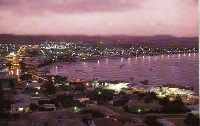
 |
Route 27 West Coast South AfricaWest Coast Towns: Saldanha Bay |
West Coast R27 Route 27 West Coast Towns Off the Beaten Track West Coast History Culture & History From Crayfish to Iron West Coast Map West Coast Explorer SA West Coast Tours/Recreation Nature Reserves Fossil Park Sea Tales & Wrecks Whale Watching Weskus Stories |
 Before World War II the shortage of fresh water hindered development on this part of the West Coast. With the outbreak of the war Saldanha Bay suddenly became very important because of its strategic position. Work started on a project to build a pipeline to provide the town with water from the Berg River. This project stimulated the development of the entire area. Before World War II the shortage of fresh water hindered development on this part of the West Coast. With the outbreak of the war Saldanha Bay suddenly became very important because of its strategic position. Work started on a project to build a pipeline to provide the town with water from the Berg River. This project stimulated the development of the entire area.Saldanha, about 140 km from Cape Town along the West Coast R27 road, is an important tourist centre of the region. The town has the best natural harbour along the entire coast of Africa, but because of the initial shortage of fresh water it had never developed into an important port. Saldanha is the 'academic' centre of the West Coast. It is home of a military academy, where members of the navy, army and air force receive academic training. Because the town also houses a naval base where young seamen undergo training, it has become well known thoughout South Africa. The military academy is situated on a prime positon above the bay, from where activities on the open sea can be monitored easily. From this natural look-out point one has an uninterrupted view of the whole bay and the sea beyond.
From a hill in the town one has breathtaking views of the town and the bay. Two solitary rocks on the hillside are known as Adam and Eve. Hotels and restaurants along the bay offer picturesque views and the exciting harbour scenes and activities are a photographer's dream. Historical BackgroundSaldanha's sheltered harbour has played a major role in the long and colourful history of the area - in many ways its history is a lot more varied and exciting that that of Table Bay. The town was named after Antonio de Saldanha, a Portuguese admiral who arrived in Table Bay with his fleet in May 1503. Ironically, he never saw the bay that was named after him. He planned to sail around the Cape of Good Hope on his way to the East but due to a navigation error, he landed in Table Bay.When the Dutch cartographer Joris van Spilbergen sailed past Saldanha Bay, he mistook it for the bay 'discovered' by De Saldanha, and named it after him. However, De Saldanha's claim to fame is his discovery of Table Bay. During the 17th century the French were very interested in the area around the present Saldanha which is why many of the islands in the area originally had French names, such as L'isle de Margaux, which was later changed to Marcus Island. In July 1863 the American Confederate buccaneer Alabama called at the port. The Americans were struck by the great natural beauty of the area and undertook several hunting trips. Tragedy struck one day when the thrid engineer Simeon W Cummings accidentally shot himself. He was buried on the farm Kliprug outside the town. His grave is still visited by many tourists, especially Americans. (Read Update on Sea Tales: Southern Naval Officer returns to Tennessee after 131 years) One of the ships that brought the French Huguenots to the Cape was forced to enter the harbour in 1688 and the newcomers had to be transported to Cape Town by wagon. When the ship Celt entered the harbour and it was found that some of its crew were suffering from smallpox, it was forced to anchor near the quarantine camp at Donkergat.
During the American War of Independence the Netherlands, France and Spain jointly declared war on England. The British immediately took the offensive and before the commander of the Dutch task force lying in Saldanha could react, the British, under the command of Admiral Johnston, had sailed between Gull and Marcus Islands and attacked them. One of the biggest sea battles in South African naval history followed and on 21 July 1781 the Middelburg was set alight by its own crew near Hoedjies Point. The German war ship Prasident, captured during World War I in East Africa was sunk opposite Langebaan to serve as a coal wharf for the whaling station at Donkergat. (Also see: History of Whaling) Of historical interest is the fact that the Batavier II, the ship on which the body of president Paul Kruger was brought from exile in Switzerland to South Africa in 1904, used this bay as its first mooring in South Africa. Also read on West Coast History and Sea Tales!: Saldanha Bay Coasters and the wreck of the Nagel: The story of the Nagel and the other coasters is very much part of the broad and dramatic sweep of South African maritime history Early Activity on the Langebaan Lagoon: On the West Coast Historical Route!!
Author and photographs, 'Saldanha' - Cornel Truter, West Coast Tourist Guide
|